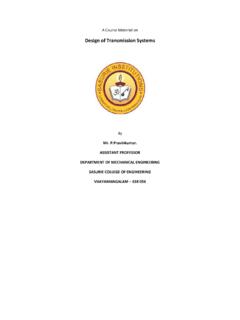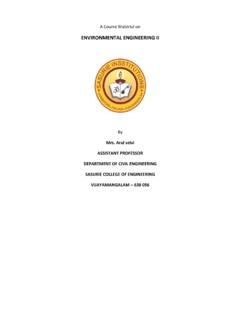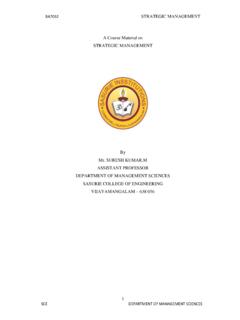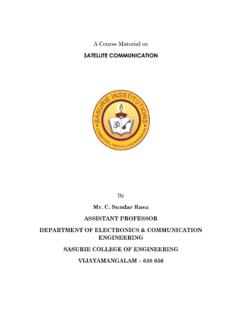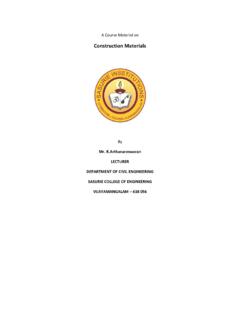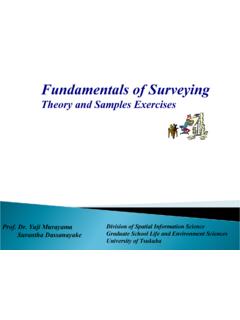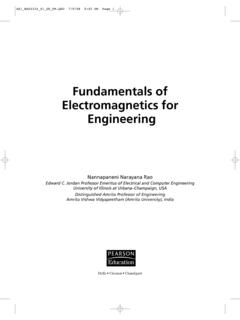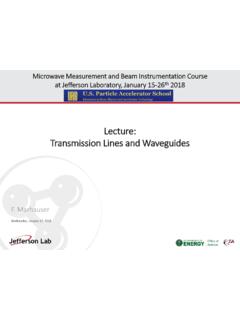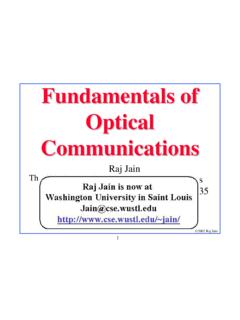Transcription of A Course Material on Transmission Lines and Waveguides
1 A Course Material on Transmission Lines and Waveguides By Mr. ASSISTANT PROFESSOR DEPARTMENT OF ELECTRONICS AND COMMUNICATION ENGINEERING SASURIE COLLEGE OF ENGINEERING VIJAYAMANGALAM 638 056 QUALITY CERTIFICATE This is to certify that the e- Course Material Subject Code : EC6305 Subject : Transmission Lines and Waveguides Class : III Year ECE Being prepared by me and it meets the knowledge requirement of the university curriculum. Signature of the Author Name : Mr. Designation: Assistant Professor This is to certify that the Course Material being prepared by Mr. is of adequate quality. He has referred more than five books among them minimum one is from abroad author. Signature of HD Name: Dr. SEAL EC6503 Transmission Lines AND Waveguides SCE Dept.
2 Of ECE CONTENTS PAGE NO UNIT I Transmission line THEORY General theory of Transmission Lines 01 The Transmission line , general solution & the infinite line . 03 Wavelength, velocity of propagation. 08 Waveform distortion 09 The distortion less line 11 Loading and different methods of loading 13 line not terminated in Zo 14 Reflection coefficient 15 Calculation of current, voltage, power delivered and efficiency of Transmission 17 Input and transfer impedance 19 Open and Short circuited Lines 20 Reflection factor and reflection loss 21 UNIT II HIGH FREQUENCY Transmission Lines Transmission line equations a radio frequencies 22 line of zero dissipation, Voltage and current on the dissipation 29 Less line , standing waves, nodes, standing wave ratio 30 Input impedance of the dissipation less line & Open and short circuited Lines .
3 31 EC6503 Transmission Lines AND Waveguides SCE Dept. of ECE Power and impedance measurement on Lines 32 Reflection losses 34 Measurement of VSWR and wavelength 36 UNIT III IMPEDANCE MATCHING IN HIGH FREQUENCY Lines Impedance matching: Quarter wave transformer 39 Impedance matching by stubs, Single stub and double stub matching. 41 Smith chart, Solutions of problems using Smith chart 44 Single and double stub matching using Smith chart. 54 UNIT IV PASSIVE FILTERS Filter fundamentals , Design of filters, 55 Characteristics impedance of symmetrical networks, Constant K, Low pass, High pass, Band pass. 60 Band Elimination, m-derived sections 67 Low pass, high pass composite filters. 72 UNIT - V Waveguides AND CAVITY RESONATORS. General Wave behaviors along uniform, Guiding structures 73 Transverse Electromagnetic waves, Transverse Magnetic waves, Transverse Electric waves, 76 TM and TE wave between parallel plates, 88 TM and TE waves in Rectangular wave guides 90 EC6503 Transmission Lines AND Waveguides SCE Dept.
4 Of ECE Bessel s differential equation and Bessel function, TM and TE waves in Circular wave guides 96 Rectangular and circular cavity resonators. 100 APPENDICES A Question Bank. 105 B University Question Papers 124 EC6503 Transmission Lines AND Waveguides SCE Dept. of ECE EC6503 - Transmission Lines AND Waveguides OBJECTIVES: To introduce the various types of Transmission Lines and to discuss the losses associated. To give through understanding about impedance transformation and matching. To use the Smith chart in problem solving. To impart knowledge on filter theories and wave guides theories. UNIT I Transmission line THEORY 9 General theory of Transmission Lines the Transmission line general solution the infinite line Wavelength , velocity of propagation Waveform distortion the distortion less line Loading and different methods of loading line not terminated in Zo Reflection coefficient calculation of current, voltage, power delivered and efficiency of Transmission input and transfer impedance Open and Short circuited Lines reflection factor and reflection loss.
5 UNIT II HIGH FREQUENCY Transmission Lines 9 Transmission line equations a radio frequencies line of zero dissipation Voltage and current on the dissipation less line , standing waves, nodes, standing wave ratio input impedance of the dissipation less line Open and short circuited Lines Power and impedance measurement on Lines Reflection losses Measurement of VSWR and wavelength. UNIT III IMPEDANCE MATCHING IN HIGH FREQUENCY Lines 9 Impedance matching: Quarter wave transformer Impedance matching by stubs Single stub and double stub matching Smith chart Solutions of problems using Smith chart Single and double stub matching using Smith chart. UNIT IV PASSIVE FILTERS 9 Characteristics impedance of symmetrical networks filter fundamentals , Design of filters, constant K, Low pass, High pass, Band pass, Band Elimination, m-derived sections low pass, high pass composite filters.
6 UNIT - V Waveguides AND CAVITY RESONATORS. 9 General Wave behaviours along uniform, Guiding structures, transverse Electromagnetic waves, Transverse Magnetic waves, Transverse Electric waves, TM and TE wave between parallel plates, TM and TE waves in Rectangular wave guides, Bessel s differential equation and Bessel function, TM and TE waves in Circular wave guides, Rectangular and circular cavity resonators. EC6503 Transmission Lines AND Waveguides SCE Dept. of ECE OUTCOMES: Upon completion of the Course , students will be able to: Discuss the propagation of signals through Transmission Lines . Analyze signal propagation at Radio Frequencies. Explain radio propagation in guided systems Utilize cavity resonators. Text Books: 1. John D Ryder, Networks, Lines and fields , 2nd Edition, Prentice Hall India, 2010. References: 1. and , Electromagnetic waves and radiating systems , Prentice Hall of Inda 2006 2.
7 Raju, Electromagnetic Field Theory and Transmission Lines , Pearson Education First Edition 2005 EC6503 Transmission Lines AND Waveguides 1 UNIT I Transmission line THEORY GENERAL THEORY OF Transmission Lines Introduction: A Transmission line is a device designed to guide electrical energy from one point to another. It is used, for example, to transfer the output rf energy of a transmitter to an antenna. This energy will not travel through normal electrical wire without great losses. Although the antenna can be connected directly to the transmitter, the antenna is usually located some distance away from the transmitter. On board ship, the transmitter is located inside a radio room, and its associated antenna is mounted on a mast. A Transmission line is used to connect the transmitter and the antenna. The Transmission line has a single purpose for both the transmitter and the antenna.
8 This purpose is to transfer the energy output of the transmitter to the antenna with the least possible power loss. How well this is done depends on the special physical and electrical characteristics (impedance and resistance) of the Transmission line . Transmission line Theory: The electrical characteristics of a two-wire Transmission line depend primarily on the construction of the line . The two-wire line acts like a long capacitor. The change of its capacitive reactance is noticeable as the frequency applied to it is changed. Since the long conductors have a magnetic field about them when electrical energy is being passed through them, they also exhibit the properties of inductance. The values of inductance and capacitance presented depend on the various physical factors are: For example, the type of line used, the dielectric in the line , and the length of the line must be considered. The effects of the inductive and capacitive reactance of the line depend on the frequency applied.
9 Since no dielectric is perfect, electrons manage to move from one conductor to the other through the dielectric. Each type of two-wire Transmission line also has a conductance value. This conductance value represents the value of the current flow that may be expected through the insulation, If the line is uniform (all values equal at each unit length), then one small section of the line may represent several feet. This illustration of a two-wire Transmission line will be used throughout the discussion of Transmission Lines ; but, keep in mind that the principles presented apply to all Transmission Lines . A Transmission line has the properties of inductance, capacitance, and resistance just as the more conventional circuits have. Usually, however, the constants in conventional circuits are lumped into a single device or component. For example, a coil of wire has the property of inductance. When a certain amount of inductance is needed in a circuit, a coil of the proper dimensions is inserted.
10 EC6503 Transmission Lines AND Waveguides 2 The inductance of the circuit is lumped into the one component. Two metal plates separated by a small space, can be used to supply the required capacitance for a circuit. In such a case, most of the capacitance of the circuit is lumped into this one component. Similarly, a fixed resistor can be used to supply a certain value of circuit resistance as a lumped sum. Ideally, a Transmission line would also have its constants of inductance, capacitance, and resistance lumped together. Unfortunately, this is not the case. Transmission line constants are as described in the following paragraphs. Distributed Constants: Transmission line constants, called distributed constants, are spread along the entire length of the Transmission line and cannot be distinguished separately. The amount of inductance, capacitance, and resistance depends on the length of the line , the size of the conducting wires, the spacing between the wires, and the dielectric (air or insulating medium) between the wires.

